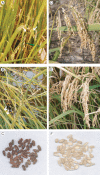The complex history of the domestication of rice
- PMID: 17617555
- PMCID: PMC2759204
- DOI: 10.1093/aob/mcm128
The complex history of the domestication of rice
Abstract
Background: Rice has been found in archaeological sites dating to 8000 bc, although the date of rice domestication is a matter of continuing debate. Two species of domesticated rice, Oryza sativa (Asian) and Oryza glaberrima (African) are grown globally. Numerous traits separate wild and domesticated rices including changes in: pericarp colour, dormancy, shattering, panicle architecture, tiller number, mating type and number and size of seeds.
Scope: Genetic studies using diverse methodologies have uncovered a deep population structure within domesticated rice. Two main groups, the indica and japonica subspecies, have been identified with several subpopulations existing within each group. The antiquity of the divide has been estimated at more than 100 000 years ago. This date far precedes domestication, supporting independent domestications of indica and japonica from pre-differentiated pools of the wild ancestor. Crosses between subspecies display sterility and segregate for domestication traits, indicating that different populations are fixed for different networks of alleles conditioning these traits. Numerous domestication QTLs have been identified in crosses between the subspecies and in crosses between wild and domesticated accessions of rice. Many of the QTLs cluster in the same genomic regions, suggesting that a single gene with pleiotropic effects or that closely linked clusters of genes underlie these QTL. Recently, several domestication loci have been cloned from rice, including the gene controlling pericarp colour and two loci for shattering. The distribution and evolutionary history of these genes gives insight into the domestication process and the relationship between the subspecies.
Conclusions: The evolutionary history of rice is complex, but recent work has shed light on the genetics of the transition from wild (O. rufipogon and O. nivara) to domesticated (O. sativa) rice. The types of genes involved and the geographic and genetic distribution of alleles will allow scientists to better understand our ancestors and breed better rice for our descendents.
Figures

References
-
- Blench R. Archaeology, languages, and the African past. Lanham: Alta Mira Press: 2006. pp. 217–219.
-
- Bres-Patry C, Lorieux M, Clement G, Bangraz M, Ghesquiere A. Heredity and genetic mapping of domestication-related traits in a temperate japonica weedy rice. Theoretical and Applied Genetics. 2001;102:118–126.
-
- Cai W, Morishima H. QTL clusters reflect character associations in wild and cultivated rice. Theoretical and Applied Genetics. 2002;104:1217–1228. - PubMed
-
- Cao ZH, Ding JL, Hu ZY, Knicker H, Kogel-Knabner I, Yang LZ, et al. Ancient paddy soils from the Neolithic age in China's Yangtze river delta. Naturwissenschaften. 2006;93:232–236. - PubMed
-
- Chang KC. The archaeology of ancient China. New Haven, CT: Yale University Press; 1986.

